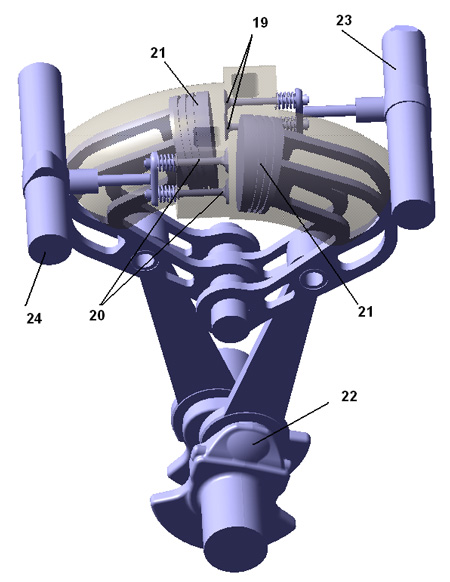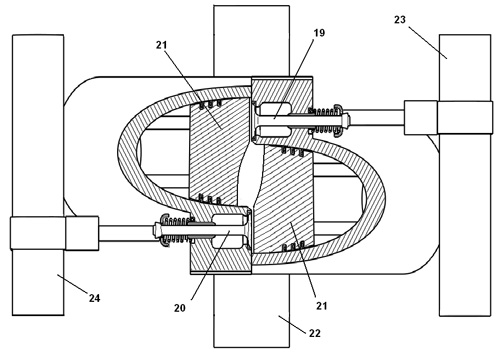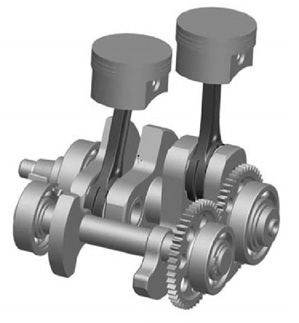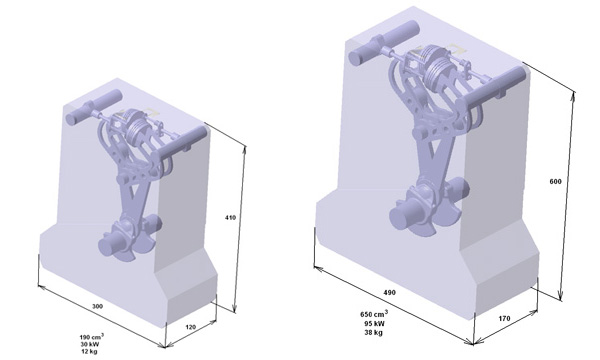HOPE - Four stroke engine
A different variant is the four stroke engine which conserves the high power density and the extended expansion stroke. It is a very simple and cheap solution without exotic elements. The space for the intake valves 19 and exhaust valves 20 are obtained by moving forward the oscillating plan of one toroidal piston 21. Consequently the toroidal pistons 21 have a parallel oscillating motion but having same rotation axis. In this case is used a single crankshaft 22. The valves 19 and 20 are poppet type, being very efficient. They are acted in a classic manner by an intake camshaft 23, respectively by an exhaust camshaft 24 or by actuators. Same valve mechanism can be used for a two-stroke variant with a single crankshaft. Missing the normal force, the skirt of the piston is eliminated and the piston weight can be reduced.

HOPE - four stroke engine

Cross section within a four stroke engine
Both two-stroke and four-stroke engines are fully balanced even they use a single cylinder (and two pistons) and consequently this solution reduces a lot the noises and the vibrations. That means, even the engine is used at high RPM, the level of NVH will be low comparing with the actual engine without to use expensive parallel shafts (see the picture billow).

"Classic Range extender" with balance shaft
[SETC2011- JSAE 20119595 / SAE 2011-32-0595
Compact Engine Architecture for Best Fuel Efficiency and High
Performance – Challenge or Contradiction
Christian Hubmann, Wolfgang Schöffmann, Hubert Friedl, Michael Howlett AVL List GmbH]
The p-V diagram of this engine can be represented in general as in the attached figure. A particularity is the extended expansion stroke obtained because the report between the double-stroke and bore can be chosen largely supra-unitary (1.8-2.2) without to increase the size and the weight of the engine. That means it can be recovered around 20% of the lost efficiency of the conventional engine.

Simplified p-V diagram
The four stroke engine can have also two compressors included in the volume of the engine. In this configuration it can obtain a huge power density in an ultra compact package.

Four stroke package illustration
The four-stroke engine can be achieved as pneumatic hybrid engine (PHE) recovering by its self the brake energy (in city drive) and the exhaust gases energy (in highway drive) with a fraction of the cost of the hybrid electric powertrain.
The basic idea of pneumatic hybridization is to use the HOPE concept not only for combustion but also for a pump and a pneumatic motor. Each cylinder of the combustion engine is connected via a valve to a shared air pressure tank. In vehicle braking phases with fuel cut-off, the engine can intake air and pump it into the pressure tank. The pressurized air can be used to boost the toroidal engine combustion mode, thereby overcoming the turbo-lag if the engine is turbocharged. The components of the pneumatic hybrid engine will be also used to partially recover the exhaust gases energy. Bellow it is shown a comparison between the electric hybrid vehicle and the pneumatic hybrid vehicle.

Visual comparison of a Pneumatic HOPE vehicle and a Hybrid Electric Vehicle
